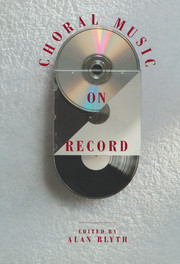Book contents
- Frontmatter
- Contents
- Preface
- Monteverdi: Vespers (1610)
- J.S. Bach: St John Passion
- J.S. Bach: St Matthew Passion
- J.S. Bach: Mass in B Minor
- Handel: Messiah
- Mozart: Requiem Mass
- Haydn: The Creation
- Haydn: The Seasons
- Beethoven: Missa Solemnis
- Mendelssohn: Elijah
- Rossini: Stabat mater Petite messe solennelle
- Berlioz: Grande Messe des Morts Te Deum L'Enfance du Christ
- Verdi: Requiem Mass
- Brahms: A German Requiem
- Fauré: Requiem
- Elgar: The Dream of Gerontius
- Walton: Belshazzar's Feast, Tippett: A Child of Our Time, Britten: War Requiem
- Stravinsky: The Wedding Symphony of Psalms
- Janáček: Glagolitic Mass
- Discographies
- Index
Monteverdi: Vespers (1610)
Published online by Cambridge University Press: 02 December 2009
- Frontmatter
- Contents
- Preface
- Monteverdi: Vespers (1610)
- J.S. Bach: St John Passion
- J.S. Bach: St Matthew Passion
- J.S. Bach: Mass in B Minor
- Handel: Messiah
- Mozart: Requiem Mass
- Haydn: The Creation
- Haydn: The Seasons
- Beethoven: Missa Solemnis
- Mendelssohn: Elijah
- Rossini: Stabat mater Petite messe solennelle
- Berlioz: Grande Messe des Morts Te Deum L'Enfance du Christ
- Verdi: Requiem Mass
- Brahms: A German Requiem
- Fauré: Requiem
- Elgar: The Dream of Gerontius
- Walton: Belshazzar's Feast, Tippett: A Child of Our Time, Britten: War Requiem
- Stravinsky: The Wedding Symphony of Psalms
- Janáček: Glagolitic Mass
- Discographies
- Index
Summary
Ideas about the performance of early music have changed radically over the past forty years. There has been considerable research on the vocal and instrumental forces Monteverdi is likely to have had in mind. For most baroque music, we now prefer an athletic and transparent texture to the lush, full sound of yesteryear. Different views of tempo go hand in hand with these ideas; in fact, in some ways they flow almost inevitably from them. Those in their turn lead to a questioning of earlier assumptions about form and design. Pitch, pitch-standards and intonation have similarly been examined exhaustively in a historical context, with results that have a fundamental impact on the performer's approach. In the particular case of Monteverdi's 1610 Vespers there has been enormous discussion of how far it is really to be seen as a single work, whether liturgical material needs adding, and if so how much. Few of these areas of discussion have led to unanimously accepted conclusions: that is often the way with historical investigation, in music as much as in anything else. And not all conductors have shown themselves equally informed or equally prepared to accept the latest conclusions at any one time. But the range of areas in which attitudes have changed means that each performance is to some extent a child of its time. The date of a recording is important.
Not that the date of itself says much about the quantity of musical pleasure to be derived from a particular recording. Most musicians would accept that there are qualities of musicianship which retain their power irrespective of historical purity.
- Type
- Chapter
- Information
- Choral Music on Record , pp. 1 - 9Publisher: Cambridge University PressPrint publication year: 1991

